“Bizarre” and “amazing” - this is how the name of the Monstera flower is translated. This beautiful liana grows in tropical forests, has large, leathery, shiny leaves and many aerial roots. Those who believe in various signs and superstitions have doubts about Monstera. Is it possible to keep this vine at home or is it more suitable for offices?
Quirky is able to predict precipitation, for which people call her “crybaby.” Before rain, drops form on its leaves.
The first thing that catches your eye is the large leaves of the plant, each of which has holes and characteristic cuts. It is they who attract gardeners and make Monstera one of the most popular indoor flowers.
Since the plant is a liana, its stem, even at home, can reach several meters in length. Therefore, the flower needs support. With good care, it can bloom and form a corn-cob-like fruit with sweet and sour flesh. Only well-ripened fruits are used for food, from which the scales are easily separated. An unripe fruit contains a lot of sodium crystals, which can cause a burn to the oral mucosa. In their homeland, plants from Monstera fruits are made into jam and used for dressing ice cream and cocktails.
Monstera at home: care features, photos
Can monstera growing in tropical forests
Many people ask this question because they doubt whether the vine can survive in indoor conditions? It turns out that there is nothing difficult about caring for this bizarre plant. In order for it to grow and delight with its beautiful leaves, you must adhere to certain conditions:
- Place in good lighting without direct sunlight. The plant even tolerates shade, so it can be grown on the wall opposite the window.
- The air temperature should be moderate. At high temperatures, the vine grows quickly and will need to be pruned.
- The flower needs to be watered abundantly, and its aerial roots should be sprayed regularly. In this case, there should be no stagnation of water in the soil.
- Every two weeks from spring to autumn, it is recommended to fertilize decorative foliage plants with organic and mineral fertilizers.
- The plant can be propagated by cuttings and air layering with leaves and roots.
- Young vines are replanted annually, and in adult plants the top layer of soil is renewed in the spring.
Having studied the rules written above, you can immediately understand - can Monstera be kept at home? This unpretentious flower is completely undemanding in care.
, but is able to decorate the green corner of the apartment with chic leaves.
Monstera reproduction. Reproduction methods at home
Monstera propagates quite easily - by cuttings, but there are certain nuances in each method. Reproduction begins in the spring. For rooting, you can use different parts of the plant. The cut of the stem is disinfected with a powder of charcoal, which must be finely crushed.
Apical cuttings
Take the tops of mature plants, cut them off and place them in a vessel with water.
It will take some time for roots to appear. Before planting the plant in a pot, you must wait for at least three shoots.
An even larger number of roots contributes to better rooting of the cutting.
Stem cutting
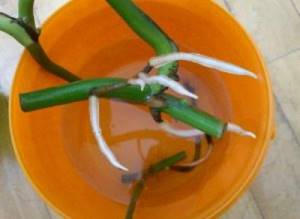
You will need a thick part of the stem with 2 or more buds. This will be the cutting. It is placed on the prepared soil (or hydrogel) so that the bud touches the surface of the soil.
Then the cutting is covered with film or glass (you get a kind of greenhouse), periodically watered and sprayed.
From time to time, the transparent protection is removed for ventilation. The cuttings are transplanted to a permanent place after roots appear.
Leaves
This is not the easiest or most reliable method, but it can be used if there are no other parts of the plant. Place the cut (or broken) leaf in a jar of water and wait for the roots to appear.
Did you know? The first monstera leaves are heart-shaped, and carved leaves appear a little later.
By layering
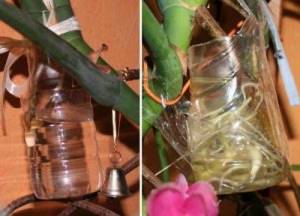
Air layering will require a lot of effort, but it will take root much better than leaves or tops. It is necessary to find a shoot with strong aerial roots and give them additional moisture.
You can tie moss and constantly wet it with water, or attach a small plastic bowl with water.
You should also protect the roots from drying out with film by wrapping it loosely around part of the plant. After a sufficient number of roots have appeared, the cuttings are separated and transplanted into a pot.
Seeds
Seeds are rarely used to propagate monstera. They germinate after 2–4 weeks in a warm and well-lit place. Mature carved leaves appear at 5–8 months. Seedlings need picking, then they need to be planted, and then replanted annually. They develop a developed root system after 2 years. After rooting, the plant lives in an intermediate small pot, and the monstera is transplanted into a large tub at 3–4 years.
Important! The monstera vine needs support, which can be a stick or trellis, as well as stretched cords.
Superstitions and signs about Monster
at
? Many people are afraid to keep this flower in their apartment because of its name, which is similar to the word “monster”. And some consider the vine to be poisonous and think that it only brings harm. Should we believe them and can Monstera be kept at home?
In fact, these are all rumors. A flower with large leaves cannot have any negative impact on human health. It has been proven that even allergy sufferers can grow the plant. Of course, if you chew the leaves, their juice may cause burning of the mucous membranes. That is why you need to make sure that children and animals do not pick leaves and put them in their mouths.
In fact, the “crybaby” vine only brings benefits:
- In Southeast Asia, the Monstera flower is
considered a symbol of good luck, health and happiness. It is placed near the patient and grown to preserve the hearth. - Large leaves collect dust on their surface and release oxygen.
- Liana absorbs the negativity that is in the house.
Thanks to this, everything is going well in the family. - According to Eastern teachings, the plant helps formulate thoughts, treats headaches, develops intelligence, and strengthens the nervous system.
If you still doubt whether Monstera can be kept in the house, then mark the vine in the office. Here it will help increase efficiency, add vigor and decorate the interior of the room with its spreading carved leaves.
Each owner decides for himself what colors to decorate the room with. It is unlikely that Monstera will be able to harm household members. A plant with fancy shiny foliage can only bring pleasure and joy.
Monstera, philodendron (translated as “unusual”) is a 5-meter, fast-growing vine. It has leathery leaves with cuts and holes. It grows and bears fruit in the tropics, but is rarely found in apartments: a tropical warm, humid climate is difficult to create. There are rumors, superstitions and signs about her - why they think that she should not be kept at home.
- The flower is considered a dangerous representative of the flora because of its name: “monstera” comes from the word “monster”. And he has no place in the house.
- Monstera is an energy vampire
. Absorbs energy and has a detrimental effect on people who appear in the room with a potty. - At night, the spreading leaves and twisted roots of the plant look like reaching arms. Looks mystical, mysterious. You'll be scared.
- The hypothesis says: the flower will create a negative aura in a house
with a favorable atmosphere, which is why it should not be kept inside. - Monstera is considered a poisonous crop
. - The sign prohibits placing Monstera in the bedroom: in portions of an adult, it absorbs oxygen and releases carbon dioxide. A person sleeping in the room will die from suffocation. The monstera breathes. Photosynthesis occurs. The flower releases more oxygen than it absorbs. There is no danger of suffocation.
- The plant is not recommended for unmarried women; the “husband” property of the plant prevents marriage. It is believed that a husband will leave his wife if he brings a flower into the house.
Scientific scientists have not been able to prove or disprove the authenticity of the signs. Make up your mind.
Considering it unsafe, do not keep Monstera in your apartment/house. The plant feels distrusted and does not grow even in an optimal climate.
Monstera esoterica. Is it possible to keep a monstera at home?
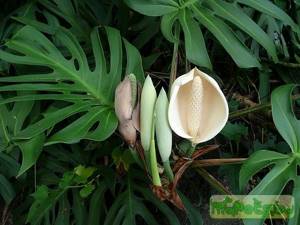
The psychic told the properties of the most mystical indoor plant - monstera. Many people believe that this flower takes energy and brings only negativity into the house. However, for some people, Monstera can become a savior plant.
Monstera is a vampire plant. Don't forget about this. Some people think that if you put it in the house, it will negatively affect the health and mood of the household. But that's not true. The main thing is to correctly use the magical properties of this flower.
According to the psychic, monstera will be useful in houses with negative energy. For example, if you are tormented by nightmares, you feel heaviness and apathy while at home, or the previous residents had a not very good history, then Monstera will help clear the space of accumulated negative energies. The psychic also recommends bringing these plants to a new home or after the death of one of the household members.
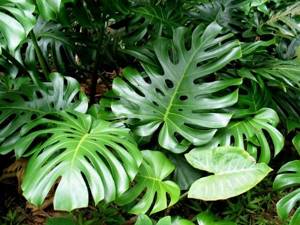
Remember that monstera feeds on negative emotions. And if you give them to her, she will grow to unknown sizes. In houses where scandals constantly occur, the monstera, as a rule, is always large and lush.
It is better to keep Monstera in the kitchen, hallway or living room. In the hallway and kitchen, she will take away from you the negativity brought from the street. In the living room, the monstera will “deal” with those who have not come to you with good intentions.
It is strictly forbidden to keep a monstera in the bedroom. Neighborhood with this plant will disrupt sleep and interfere with proper rest and sleep. As a rule, monstera in the bedroom is often the cause of constant fatigue, lack of sleep, nightmares and various mental disorders.
How does it affect a person?
The sign reads: The plant steals human energy, sucks out positive emotions, disrupts the aura, and has a bad influence on the human causal body. Personal life, career, destiny will be destroyed. Fatigue, weakness, irritability occurs: the plant spreads negativity.
Harmful properties of the flower
- The juice is poisonous
. It is not a poisonous plant. The juice contained in the leaves of the flower is poisonous. If it comes into contact with human mucous membranes, it will poison or kill. Happens when biting or biting the leaf. Indians and Australians love the fruit. In the East they are considered delicacies. The “berries” of the plant are specially grown. They have a banana taste and pineapple aroma. - Dangerous for children
. The leaves contain needle-like formations. They will cause irritation of the mucous membranes. An allergic reaction will occur. The fact is scientifically proven. A small child or animal will harm itself. Better give up the idea of keeping Monstera or be careful.
For what reasons is it a dangerous representative of the flora? Why is she at risk?
Monstera appeared in Europe in the eighteenth century. There were legends about the 5-meter killer plant found in the wilds of South America. According to travelers, the plant attacked people and animals
, pierced the bodies with long branches, leaving skeletons. Stories based.
The wanderers mistook the roots for tentacles. They hung down and grew through the skeleton of a man who died in the jungle. The travelers imagined a different picture of death.
The plant received its Latin name “monstrum” because of these legends. Since then it has been considered a dangerous representative of the flora.
What facts favor Monstera?
Positive traits:
- Wellness, healing
. Delays negativity, heals, relieves a person from severe headaches. Relax near the pot - this can be done without fear. In Eastern countries it is considered healing. In Thailand, branches are placed near a sick person: he will recover. In Laos they place it at the entrance to the house as a talisman. - Eliminates clutter
. Eliminates clutter, organizes thoughts, concentrates, and increases a person’s attentiveness. There will be harmony and order in the house. - Protects
. It is considered a talisman, the keeper of the hearth. Brings happiness, luck, harmony to the house. - Relaxes
. The flower relieves tension and drives away stress. Helps you fall asleep or ward off insomnia. - Decorates
. The spreading leaves of the vine will decorate the interior of the apartment and give it a tropical look.
Beneficial features
- Leaves enrich the air in the apartment with aerons
and oxygen. They cleanse the atmosphere of carbon dioxide and unpleasant odors. - The flower's ability to release moisture makes it a natural humectant
. The plant will ionize and humidify the air in the apartment. - Purifies oxygen from harmful impurities
. The air will be fresh. This will relieve headaches and illnesses. - The plant will collect dust
on its spreading leaves and clean the house. - Will not allow viruses, harmful microorganisms, or fungi to develop.
- Monstera - home barometer
. The appearance of water drops on the leaves means rain. - Eastern scientists have confirmed: Monstera helps strengthen the nervous system
, develop intelligence, treat headaches, get rid of clutter, and formulate thoughts. - It sucks out substances that are toxic to humans (the smell of building materials) from the air.
- Absorbs electromagnetic waves.
Monstera's favorite places are near the refrigerator, TV, microwave oven. Should not be placed in the bedroom or children's room.
General
When does it bloom?
Blooming Monstera is a rare sight
. It is believed that it is difficult to make it bloom at home.
- diffuse lighting
- regular watering and spraying
- fertile loose soil
- stock pot
- temperature 20-25°C
Monstera blooms annually in summer when conditions are met.
How does it bloom?
At home, Monstera grows 5 meters long
. Adventitious roots grow and descend from the stem.
Cream flowers appear in summer. A year later, the purple fruits ripen. They are edible and have a tropical fruit aroma and pineapple flavor.
Do not eat unripe fruits! The mucous membranes become inflamed.
Data
- Native to South America;
- In tropical forests it reaches a height of 30-40 meters;
- Rarely gets sick;
- In demand all over the world;
- Aerial roots provide additional nutrition;
- Grows in partial shade;
- Does not tolerate direct sunlight
.
Monstera in its natural environment - in the tropics
How to care for monstera at home
Lighting
The liana feels good in diffused sunlight and tolerates shade well. But here it is important to find a balance between light and shadow, since with a lack of lighting, new leaves grow small and whole without cuts, and the stems and aerial roots are weak and thin.
In the shade, the plant also exhibits negative phototropism, when new shoots develop towards the shade, since in the jungle darkness signals the presence of a large tree that the vine can climb up to reach sunlight.
Exposure to bright rays in the spring and summer causes burns and yellowing of the foliage, but the variegated form is less sensitive to direct sun.
Temperature
The optimum temperature throughout the year is 18-24 °C. The tropical beauty can tolerate cool winter conditions of 13-15 °C, but growth will slow down in this case. Cooler temperatures cause dark spots to form on leaves. The culture is also sensitive to drafts.
How to water monstera
Caring for indoor monstera includes regular, abundant watering during the active growing season, approximately once a week after the top layer of the substrate has dried. In late fall and winter, in cool conditions, watering once every two weeks is sufficient. Water for irrigation is taken soft and at room temperature.
Proper watering of phalaenopsis
The plant responds gratefully to increased air humidity, especially in summer. In summer, spray the vine with slightly warm water every other day; in winter, once a week is enough. The flower reacts to dry air by drying out and yellowing the tips of the foliage.
To increase humidity, you can place the pot on a stand filled with water and expanded clay, making sure that the bottom of the pot does not come into contact with water. Once a month, it is recommended to wipe the wide leaves of the vine from dust.
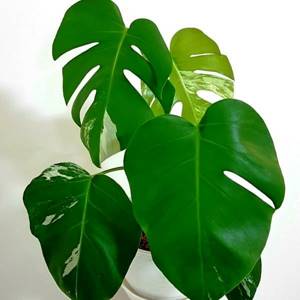
Monstera deliciosa var. borsigiana
The dark green, shiny leaves of this exotic beauty have a unique feature: they can “cry”. Excess moisture is released through special mouths at the edges - these are the “tears” of the monstera. This phenomenon may also indicate approaching rain.
Feeding
A monstera flower at home needs regular feeding. After planting the seedlings, when new growth begins, feed the year with a solution containing predominantly nitrogen.
In subsequent years, throughout the growing season, feed with liquid mineral balanced fertilizer, diluted in water once every 2-3 weeks. If you do not provide enough nutrients, the leaves will become pale and their edges will turn brown.
The best homemade fertilizers for flowers
It should be borne in mind that the lower the lighting, the less fertilizer is required. If we grow indoor monstera in a shady corner of the room, then we feed it once every 20 days. Fertilizers are not applied in the autumn-winter period.
Transplanting monstera at home
The vine is transplanted once a year in the spring, but only until it reaches a height of 1 meter. Adult specimens are replanted every 3-4 years, but the top layer of soil must be replaced with a new one annually. First water the plant, then remove 2.5 cm of soil and fill the pot with fresh soil.
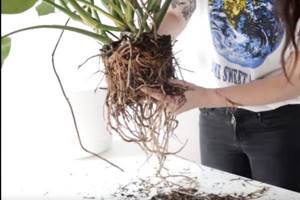
What is the best pot for Monstera? Any container is suitable, but the vine is more stable in clay and ceramic pots. Before planting, be sure to pour a layer of expanded clay or small crushed stone at the bottom of the pot for better drainage.
Soil for monstera. For replanting, universal flower soil, peat and perlite (sand) in a ratio of 2:1:1 are suitable.
How to prune monstera
The plant produces long aerial roots on its shoots. Many novice flower growers ask: is it possible to trim the aerial roots of Monstera? Despite the fact that the roots slightly reduce the decorative value of the vine, it is not recommended to trim them.
During transplantation, the roots that reach the ground are laid out on the soil for rooting, due to which the plant receives more nutrients. Roots that are too long can hang loosely around the pot, but it is better to collect them in bunches and lower them into containers with water.
The height of large, old vines that have lost their lower leaves can be adjusted by cutting off the top in early spring. The procedure rejuvenates the plant well, stimulating the growth of side shoots.
How is a flower used in Feng Shui practice?
Feng Shui is popular in the East and teaches how to design a living space that is in harmony with nature. It reads:
- Monstera organizes human thoughts
and helps to clearly formulate them. - The flower pushes a conservative person to action.
- Reduces marital libido, unites the masculine and feminine (Yang + Yin). Don't put it in the bedroom.
- Affects decision making
. Helps in negotiations.
From the above statements it follows: Monstera has no place in the bedroom
. Place it in the hallway, kitchen or family room.
Monstera is found in meeting rooms and directors' offices: it helps in decision-making and negotiations.
Opinions about the usefulness and harmfulness of Monstera are divided. Decide, but know: love will respond with love, and in the absence of care, a flower does not grow.
The beauty of the monstera plant is beyond doubt. However, many rather controversial signs and superstitions arose around him. Some of them are associated with luck, others have the exact opposite meaning. What is the root of these superstitions, and is it worth having a monstera in your apartment? Read the article.
The plant-liana philodendron (this is the name Monstera also bears) has long been overgrown with many legends and beliefs. Some consider the monstera a symbol of good luck, while others, on the contrary, believe that the presence of this flower in the house can destroy a family and bring misfortune. However, the only problem that arises when a monstera appears in the house is the careful care that the plant needs to provide. After all, it comes from the humid tropics, so our climate is, to put it mildly, poorly suited for philodendron.
What does a monstera plant look like: photo
The name “monstera” in translation means “amazing” or “bizarre”. All three names can be easily explained by the appearance of the plant.
- The huge leathery leaves of this vine can reach 45 cm, and the slits and holes in them add even more mystery to the image of the monstera and give it a frightening appearance.
- With proper care, the length of the monstera reaches several meters, so when starting a monstera, try to provide the plant with reliable support.
- It has a developed system of aerial roots, with the help of which it climbs. It is not recommended to remove roots growing from the nodes of the main stem. You can direct them to the plant's pot or make separate bags of soil for each root. If there is a lack of soil, it will not climb.
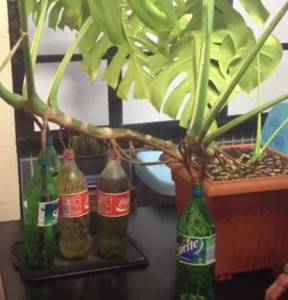
- Monstera blooms annually, the flowers resemble a cob.
Important: With insufficient care, if you cannot provide the plant with comfortable climatic conditions, you may not see flowers.
- Monstera is a natural barometer. In cloudy weather, before rain, its leathery leaves become covered with moisture. The hydathoda organs located on the lateral veins are responsible for the secretion of this actually sticky juice. It is they who, when humidity is high, release liquid that flows from the wide leaves, as if the plant is “crying.”
Monstera (description)
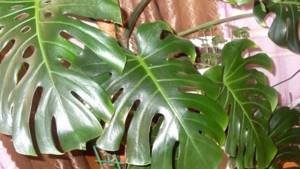
Appearance
Monstera is a beautiful ornamental liana plant similar to a palm tree, which has a large number of aerial roots with massive leathery leaves with holes. Their length sometimes reaches 30 cm.
The flower's homeland is the humid tropics. It is this hot and humid climate that is most suitable in which the plant grows and bears fruit. Home conditions are not capable of creating such conditions, so flowering in an apartment is a rare occurrence.
Very often this plant is called “crybaby” because of its ability to predict the weather: if large drops appear on the leaves, it means it will rain.
The word “monstera” has several translations that exactly correspond to the type of flower:
- whimsical;
- yoke;
- amazing.
Is monstera harmful or poisonous to human health: impact on humans
Contrary to popular belief about the bad effects of monstera on health, it has been proven that it is absolutely safe even for people who suffer from allergies.
The myth about the poisonousness of the plant is also slightly exaggerated. Indeed, there are needle-like formations in the leaf tissues. If the juice gets on the mucous membrane, a burning sensation or even poisoning may occur. There are a number of symptoms to determine it:
- Numbness of the mouth
- Throat irritation
- Swelling of the mouth and throat
- Soreness
- Loss of voice
- Dysphagia
It is worth noting that such a reaction is only possible with close contact with the leaves, for example, if you rub the leaf and then rub your eyes or chew it.
Based on the above, we can conclude that the monstera can cause real harm either to pets who like to snack on flowers, or to inquisitive young children without supervision.
Interesting fact: The peoples of Southeast Asia believe in the medicinal power of the plant. Sometimes it is grown precisely in case of illness. Monstera is placed at the patient’s bedside, and sometimes they are even given a leaf to chew.
Is it possible for an unmarried woman to keep a monstera at home?
Superstitions and myths floating around monstera say that this plant can destroy a person’s aura and energy protection. As a result, personal life and health are disrupted. Therefore, unmarried girls are not recommended to have a monstera.
It is noteworthy that the monstera is called muzhegon along with ivy, but there is no evidence for this theory, everything is limited to superstition.
In addition, it is worth remembering that in its homeland the philodendron is considered a symbol of the family hearth. The bad reputation around him only extends far from his habitats.
So can you keep Monstera at home or not?
As you can see, myths about the plant are maintained thanks to the people who believe in them. The plant does not pose any danger if you handle it carefully (remember that it is poisonous and do not chew the leaves!) However, you do not need to have a monstera at home if you have any concerns about it. This flower, like any other, perfectly senses the attitude of those around it. And even if you create optimal conditions, if the atmosphere is hostile, the flower will die. But if you take a risk, throwing away all prejudices, having a monstera in your home will bring you only joy and benefit.
Where should Monstera be located in the house?
Like any plant, monstera breathes around the clock. However, when choosing a place in the house for it, it is important to take into account one feature of this vine.
During daylight hours, it absorbs carbon dioxide and releases oxygen. At night, the reverse process occurs - the plant releases carbon dioxide. This is explained by the process of photosynthesis during daylight hours.
Important: Please note that monstera still releases more oxygen during the day than carbon dioxide at night, so you should not fear for your health. This beautiful plant will decorate your home.
It is worth mentioning that Monstera absorbs electromagnetic waves, so its ideal placement is near electrical appliances (refrigerator, TV, computer).
Keep in mind that monstera is a fairly large plant. If it is not tied to a support and does not send roots into the pot, it can occupy a large area. In addition, it does not like direct sunlight, so it is better to choose a place where there is partial shade or diffused light.
Monstera: care and reproduction, video
A liana native to the tropics is known for its huge, perforated leaves.
There are about thirty species of plants in total, but Monstera deliciosa has won the hearts of flower growers.
It is unpretentious, you just need to maintain high humidity in the room.
With proper care, the vine reaches a height of 6 m.
However, the terrifying name and large leaves have given rise to many superstitions.
: people are afraid to breed monstera in apartments.
Myths
Colonizers of the 18th century, making their way through tropical forests, were frightened by the terrifying appearance of the vine. Dissected leaves with drops of moisture appearing before the rain, as well as gnarled stems and long aerial roots did not cause delight.
It is worth mentioning how the monstera blooms: the white inflorescence from a distance resembles a hood. After flowering, an elongated fruit appears.
Modern skeptics focus on the dissonant name and the idea that the plant absorbs a lot of oxygen at night. It is believed that the rate of consumption in the dark for Monstera is the same as for an adult. Hence the myth that you can suffocate in your sleep if a flower pot is in the bedroom
.
Attention!
The leaves of the vine do not pose any danger to either a sleeping or a waking person. It breathes around the clock, but in daylight photosynthesis occurs, that is, the plant releases more oxygen than it absorbs.
The poisonous nature of the vine is another misconception. There are rumors that you can be poisoned by any part of the plant. In fact, only the needle-like formations located in the leaves are dangerous.
When they get on the mucous membrane of the mouth, they cause irritation. The remaining parts are safe. In Asian countries, monstera fruits are added to various dishes.
Superstitions
Some people like to blame indoor flowers for failures in life, lack of money and poor health. They believe that certain plants have negative powers: cacti, ivy and ficus.
The tropical monstera vine also fell into disgrace. So why can't you keep this green pet at home?
Based on modern superstitions, the plant is an energy vampire
. It sucks the strength out of a person. Allegedly, monstera poses a particular danger to women.
The owners of the apartment in which a flower pot appeared soon lose their appetite and become apathetic. They are haunted by a series of troubles.
If such rumors had a real basis, then the culture would not be so popular among flower growers. All kinds of monstera photos from the Internet clearly illustrate that the vine fits perfectly into the interior of apartments.
Various forums for indoor plant lovers contain separate threads in which people actively communicate about caring for Monstera at home.
For example, in this video, the owner shows the huge indoor monsters living in her home:
Monstera flower description. Monstera plant description
Monstera is easy to care for, evergreen with fleshy leaves, it will decorate your room in winter, when many plants have gone into hibernation. Don't forget that the vine can grow all the way to the ceiling. It is grown in special boxes, buckets or tubs. In addition, the plant needs strong support. With its help, you can direct the plant to vertical growth.
Monstera can climb along special ladders on the wall, like other types of vines. But this method of growing plants takes up too much space. In addition, as the vine grows, roots appear that hang in the air.
They need to either be directed downwards in such a way that they reach the soil in the plant’s pot, or a bag of soil should be hung from each root. Monstera needs adequate nutrition, but when many roots hang in the air, this is almost impossible.
Depending on its species, Monstera can grow from 30 centimeters in length and above. Liana lives well in a room adapted as a winter garden, where it is well heated. The homeland of this large plant is the tropics, the island of Yutacan and Brazil. At the beginning of the 20th century, Monstera came to the countries of Southeast Asia and from there it was brought to Russia.
Lovers of indoor flowers enjoy growing Monstera because of its beauty and easy care. What kind of Monstera care there is at home, photos can be viewed on the websites of flower shops, travel portals, in communities of summer residents and flower growers.
Reality
In fact, the indoor plant secretes phytoncides that destroy pathogenic microorganisms
. Today there are many varieties of monstera: compact, variegated, with patterns on the leaves. Most often, gardeners prefer the following types:
- Monstera deliciosa
. A classic vine with perforated dark green leaves. A few years after planting, it may begin to bear fruit.
- Monstera oblique
. The plant is small in size, unlike other species, has leaves with oblong holes. They may have veins of different shades, which makes the appearance of the vine even more original.
- Monstera is doubtful
. The capricious indoor flower has variegated leaves, which is why it is often confused with.
Is it possible to keep an exotic vine at home? Monstera? Of course yes. But you should know that it develops quickly, requires large areas and high humidity. Therefore, the plant is suitable for offices and hallways of large organizations.
Carefully!
There is no need to place the potty in narrow corridors. The leaves are easily injured by touching; Due to drafts, they may turn yellow and fall off.
Monstera - a flower from the tropics
The flower got its name thanks to the picturesque imagination of European travelers. They told legends about giant killer plants living in the South American tropical wilds! The aerial roots of monstera hanging from trees could easily be mistaken for tentacles, and the impressive size of the plant terrified discoverers inexperienced in floriculture. Thus, the flower received the name “monstera”, which translated from Latin means “monstrum” - “monster”, and from Latin “monstrosus” - bizarre, amazing.

m. in nature, photo by the author
Monstera is an evergreen liana with large, up to 90 cm in diameter, carved figured leaves. For the most part, it is distributed in the humid tropics of South America: in Mexico and Brazil, on nearby islands. Monstera also took root in Southeast Asia, and in the 17th century it was brought to Europe, becoming a favorite indoor flower in the 18th century. The study of monstera varieties continues to this day! Thus, University of Missouri professor Thomas Croat, who systematizes the types of aroid plants, described six species of monstera at the end of the last century.
In the wild, the vine grows up to 10-15 meters and blooms regularly. At home, Monstera indoors can grow up to the ceiling; it blooms extremely rarely, but is quite unusual. The flower, about 20 cm in size, looks like a cob, wrapped in a white blanket, and is similar in appearance to calla lily flowers.
Is it possible to keep a monstera at home? It is believed that Monstera is not the most suitable flower for bedrooms and relaxation areas. According to Feng Shui, this plant has very strong energy and can cause insomnia. However, in large halls and halls this giantess will come in very handy! You can read more about flower feng shui zoning here.
In nature, wild vines differ in the shape and degree of “holeiness” of the leaves, as well as in the color of the foliage. Of the many varieties, the one most often found indoors is Monstera holey (or pleasant). Its ovoid leaves, reaching a length of 60 cm and 30 cm in width, have uniform “cuts” on both sides along the veins.
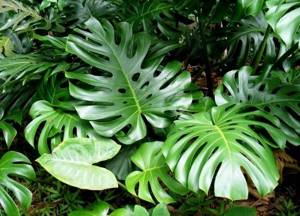
m. leaky
Monstera oblique is the second most popular variety. This is the most miniature and elegant species, unlike the previous one, its lanceolate-shaped leaves are whole, but have uneven oblong slits. Sometimes there are so many slits that the sheet turns into an openwork plate.
✿
Monstera and feng shui
According to the Chinese teaching about achieving harmony with the outside world, the monstera combines the masculine and feminine principles. Residents of the apartment will be able to cope with problems if the pot with the plant is located in the kitchen or living room.
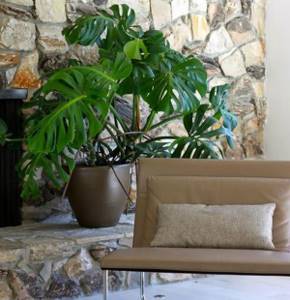
Monstera in the office will push the owner of the room to take decisive action that will lead to success. According to Feng Shui, the liana has strong energy, so it is not placed in the nursery or bedroom.
Concerns about Monstera are not well founded
. All of them are based on myths and superstitions. The heat-loving vine requires a lot of space for harmonious development. This is the only reason why it is better to grow it in office premises rather than in an apartment
There are many superstitions associated with house plants that arose in ancient times, but have survived to this day. It is worth finding out why it is dangerous, why you cannot keep this flower at home and whether the culture is poisonous. To believe in omens or not is everyone’s business.
Monstera - signs and superstitions
It is popularly believed that indoor plants can influence the energy of the house. There is a version that crops with round leaves can bring harmony to the home. One of the explanations can be found in the signs why you can’t keep a monstera at home - because of its sharp leaves, it is an energy vampire. It is believed that the plant is capable of not only absorbing energy, but also introducing an imbalance into a person’s life, worsening his well-being.
Monstera at home - signs
Since the flower is an energy vampire, it is able to absorb not only positive, but also negative energy. According to superstitions, in order to free yourself from negativity, you need to spend some time near the potty. It is indicated in the signs whether it is possible to keep a monstera at home, that if negative energy reigns in the room, then the plant will be useful and vice versa. There is a superstition that explains why you can’t keep it in the house, and this is due to the fact that this flower culture is classified as muzhegon.
Many people want to know why monstera is dangerous, and why you can’t keep such a flower at home, not suspecting that it actually has benefits:
- All large-leaved crops are considered monetary, that is, Monstera is capable of attracting material wealth to the house.
- There are Eastern superstitions that indicate that it should be placed at the bedside of a sick person, which will promote a quick recovery. Some people even grow Monstera near their home to serve as a talisman.
- It is believed that Monstera has a healing and healing effect, so with its help you can cope with headaches. The leaves contain an unusual substance that is released into the surrounding space and provides benefits. The thing is that it has an antibacterial and anti-inflammatory effect.
- With the help of a flower you can organize your thoughts and calm down. You should not place it in places with positive energy, but in other cases it will help achieve harmony.
- Monstera is a natural barometer because small droplets of moisture appear on its leaves before rain.
Monstera in the office - signs
If you think that you can’t keep such a flower culture in the office and other public places, then this is a mistake. It is believed that it can enhance thinking and concentration, which will be useful during work. The best place for monstera is meeting rooms and offices. It is also useful for the office because it can enrich the air with oxygen, trapping dust on the leaves. According to signs, Monstera helps cope with stress and tension.
Beliefs about the monstera flower. Myths and legends.
Monstera is a tropical plant that is a vine. Brazilian forests are considered the homeland of the monstera; in the wild it can reach simply gigantic sizes. There are many beliefs and legends around this flower, which, in general, corresponds to the meaning of its name. After all, when translated, monstera means bizarre, amazing. The plant produces fruits, but you cannot eat them, as they are poisonous.
Opinions about the monster.
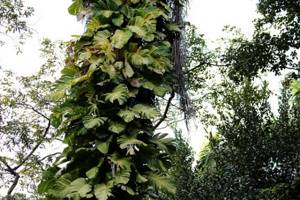
Many people are very wary of Monstera. Because since ancient times there has been an opinion that the plant is an energy vampire, slowly killing its owner due to the poison that penetrates the atmosphere. In addition to this belief, there is speculation that Monstera is a catalyst for the collapse of a family. Due to the fact that this flower is considered a vine, especially impressionable people are afraid that it will strangle them in their sleep.
Myths and their debunking.
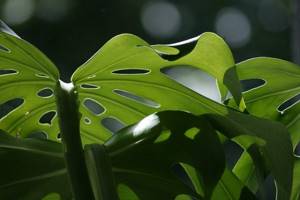
People often think that the name of the flower comes from the word "monster". Therefore, it contains a lot of sinister and monstrous things. But this has nothing to do with reality, and the name of the flower does not come from this word.
1. Residents of countries that are home to monstera do not keep it at home. It is believed that it sucks the life force from the owner. The longer the plant is at home, the worse the condition of the owner and his loved ones becomes. Family relationships deteriorate, illness comes to the house, and unmarried girls completely lose their chances of future marriage. If there is a monstera in the house, then all misfortunes are associated with it, and soon it leaves the home. In principle, this cannot be considered a serious superstition.
Since, for example, in Ancient Greece the monstera personified family and goodness. According to Feng Shui, the plant should be kept in the marital abode because it promotes a happy family life. Suspicions about attracting negativity into the house have no basis at all, since people themselves are responsible for their actions and it is certainly not the flower that creates a bad environment in the house.
Also read: Organization of heating in the country house
Legends
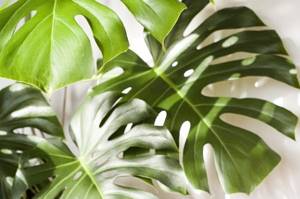
Therefore, if she is next to a sleeping person, then he may die from lack of air. In reality, this is simply impossible, since monstera, like any plant, feeds on carbon dioxide. 3. Some superstitious people believe that monstera juice is so poisonous that if even a small amount of it gets ingested by a child or pet, it can be fatal. But in fact, the juice is not as poisonous as many people think. It contains microneedles, which, if they enter the body, can cause a feeling of discomfort and burning.
Thus, it is obvious that the myths about the monstera have absolutely no basis. And they are simply designed for suspicious and superstitious people. The fact is that there is a power of prejudice and if a person believes in all this. Then most likely this will actually start to happen. Therefore, you should not believe in unverified facts and live peacefully with your monstera under one roof.
If you are interested in everything unusual about the dacha, come here
Why is monstera dangerous?
If a person is superstitious, then it is better not to keep a monstera at home, so as not to live in fear that it can cause harm. Science cannot give a definite answer as to whether the reasons why one cannot have such a “monster” at home are true or deceptive, therefore each person has the right to independently decide whether to believe in them or not. When finding out why the monstera flower is dangerous and why it should not be kept at home, it is worth noting that some people consider it poisonous and even fatal to animals.
Monstera - poisonous or not?
In fact, this houseplant is not poisonous, and claims to the contrary are false. Many people are interested in whether the monstera is poisonous to children and animals, so it’s worth knowing that the flower cannot cause significant harm even to them. It is important to point out that there are even edible species in India and Australia. The only problem that can be caused by Monstera is due to the presence of inconspicuous needle-like formations located on the leaves. If they get on the skin and mucous membranes, a slight burning sensation occurs, which goes away in a short period of time.
Such a necessary monstera flower! This is important to know!!!
Hello friends. I am very glad to meet you again. And if this is your first time on my blog, I am also sincerely glad to meet you. I hope you enjoy it here and come back again and again. And I will do everything possible so that your time spent on my blog is not wasted, by the way, for all new visitors who leave their first comment there will be a small gift. Well, for now, let’s return to the topic and in this article you will learn about such a wonderful flower as the monstera, about its amazing, magical properties, you will find information about how the plant helps solve many problems and change lives.
Before starting the article, I want to say that, firstly, the plant will greatly help people whose house is constantly in chaos and they can’t do anything about it, but first things first.
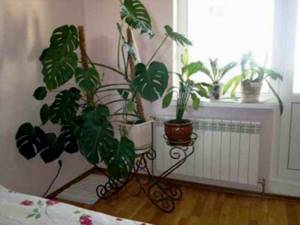
The illustration for the article is taken from open sources
Monstera flower is one of the plants that belongs to the zodiac sign Virgo. So, the monstera flower has all the attributes of the Virgo sign and is its most prominent representative. Monstera has a thick stem and aerial roots. But the secret of this plant lies in its leaves. The leaves of this plant seem to be cut into several parts. And each part of the sheet has its own direction. This speaks of such a quality of the plant as love of order.
So the monstera flower is simply necessary for people who have no order not only in the house, but also in their own heads. Or people often come to visit you with a real “mess” in their heads, those people who bring house and disorder behind them.
So what if a person doesn’t understand the meaning of order and doesn’t know how to maintain it, you ask. After all, you often hear on TV or read in newspapers that disorder is the lot of creative people. There wouldn't be anything wrong with that. But the whole point is that such a person, with his energy of disorder, brings a mixture of energies, as a result of which real chaos begins.
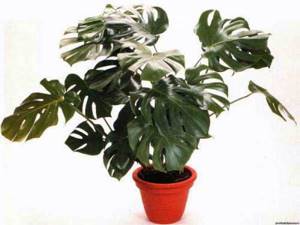
The illustration for the article is taken from open sources
Such mixed energy negatively affects people who live on several topics. For example, home - work - family - friends - hobbies, etc. In a house where a messy person lives, others will not be able to multitask and focus on only one thing. In such a house it is difficult to realize your creative projects and generally fantasize. In general, in such a house, all other residents simply become bored.
Fortunately, the monstera flower knows how to absorb the energy of disorder, preventing it from mixing with the atmosphere of the house. So, if there is a person living in your house who does not value order at all, you are tired of constantly putting scattered things back in place, or there is real chaos in this person’s head, then get this plant urgently.
Monstera flower also helps a person not to say too much. This plant will help people who dream of not making unnecessary speeches, but saying only what is needed. The plant helps to put thoughts in order and a person will begin to understand what needs to be said and when.
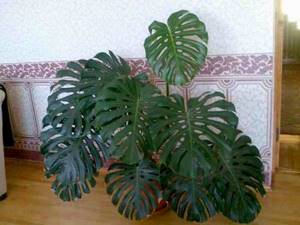
The illustration for the article is taken from open sources
This plant is simply a godsend for those who do not understand when and what to say, who simply do not know how to get a word in at the right time. Monstera will help a person learn to speak with any person in his language, always finding the right words.
The monstera flower also has a good effect on conservative people who have great difficulty changing their views and beliefs, even if life requires them to change their minds. Give this man a monstera.
The plant will help a person become more flexible and adapt more easily to any current situations. Thanks to this plant, a person will be able to deviate from his own rules in time and act as the situation requires. The plant is very useful for stubborn people.
Monstera has a beneficial effect on the abdominal organs and intestines. This plant can protect you from poisoning.
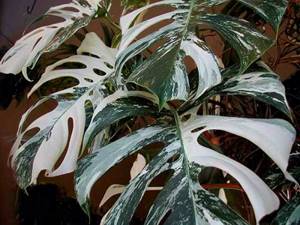
The illustration for the article is taken from open sources
This is the monstera flower. So decide for yourself whether you need it or not. Unfortunately, I personally simply have nowhere to place this plant, so I will refrain from purchasing it. Well, that's all I wanted to write about this indoor plant.
Here you will learn how to care for monstera:











